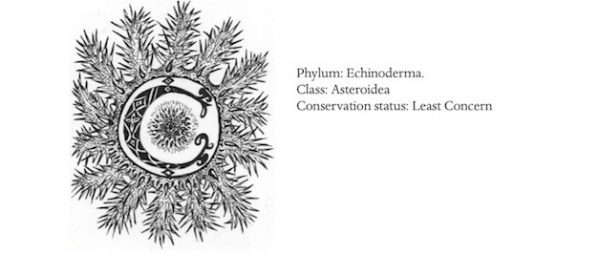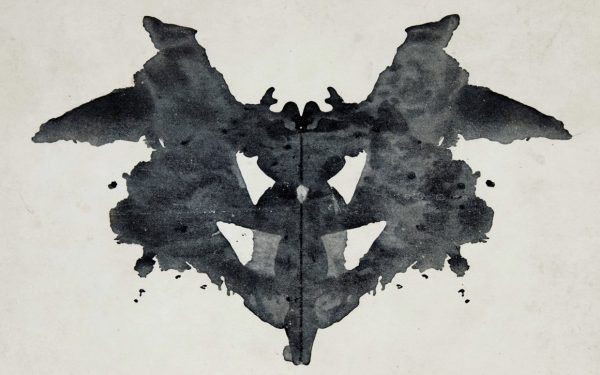If you look into infinity what do you see? Your backside!
–Tristan Tzara
The drug-addict, drunk, wife-shooter and writer William Burroughs used to tell a story about a man who teaches his anus to talk. The orifice eventually takes over his life and kills him. Wildlife can be as least as weird as the imagination of Burroughs. Consider the Crown of Thorns starfish. Instead of a head it has an anus on the top of its body, while its mouth – a round hole equipped with inward-pointing teeth at the centre of the radiating arms – is in the middle of its underside.
This positioning is less unusual than you might think. Having a mouth underneath and an anus on top is ideal if you want to eat crud on the seafloor, and this is how the ancestors of the Crown of Thorns started out. Many of its distant cousins, among them starfish and sea cucumbers, still pursue that lifestyle. (On the abyssal plains, the so-called desert of the deep sea floor, large herds of sea cucumbers are constantly grazing on the detritus that has fallen from above. They are the night-soil men of the deep in a holothurian heaven.) Unlike these animals, however, the Crown of Thorns is no longer a scavenger, having acquired a taste for living flesh. Dressed in brilliant shades of purple, blue, orange red, white and grey and with anything from seven to twenty-three (but usually about fifteen) rays around a central dome, it bristles with poisonous spikes – a submarine version of Pinhead, the extradimensional being in the horror film Hellraiser.
Many creatures in the garden of earthly delights that is a tropical coral reef have more charm than the Crown of Thorns. (Pfeffer’s Flamboyant Cuttlefish, which turn itself startling hues of purple and pink at will while posturing like an actor in Noh theatre, is one of my favourites.) But few are more compulsively unsettling than the Crown of Thorns, and few are as like us in their power to consume and destroy once they set to work.
The claim may seem odd in view of our obvious differences. The Crown of Thorns crawls over the reef on thousands of tiny podia – tube-feet, through which it also breathes, that extend and flex like hydraulic parts as they fill and empty with fluid from sacs inside the animal’s arms. Gliding along about as fast as the minute hand on a clock (a little faster if it puts on a turn of speed), it moves more like a millipede than (as one might suppose) a severed human hand pulling itself by the fingers over the seabed. Once it gets into position around its favourite food of freshly growing coral, the Crown of Thorns wraps its arms around its object of desire in a grip of death, extrudes one of its two stomachs through its mouth and spews digestive juices over the polyps, turning them into a gooey mess which it sucks back inside itself. When Crown of Thorns starfish swarm in large numbers they can devastate a reef in a few days And thereby hangs a true tale resembling many a B movie about monsters from the deep.
Until the 1960s few marine scientists had seen, let alone studied the Crown of Thorns starfish. It was known to eat coral but thought to be quite rare. Then a large-scale infestation was observed munching its way through the reefs surrounding a small cay on Australia’s Great Barrier Reef that was popular with tourists. By the end of the decade they were reported in huge numbers on large areas of the GBR and seen attacking many other reefs throughout the Indo–Pacific.
The press cried apocalypse. In July 1969 the New York Times reported that the Crown of Thorns threatened the food supply and even the physical existence of many tropical islands. It quoted the conservationist Richard Chesher: ‘if the starfish population explosion continues unchecked, the result could be a disaster unparalleled in the history of mankind.’ In November of that year the Economist reported that coral reefs across the Pacific were ‘crumbling, and the economies of whole regions could crumble with them’.
It looked like precisely the kind of payback predicted by environmentalists such as Rachel Carson and Barry Commoner: human thoughtlessness was upsetting the ‘balance of nature’, transforming the hitherto obscure Crown of Thorns into a predator without limits by eliminating whatever it was that normally kept it in check or by altering nutrient and chemical balances in the seas. In the end catastrophe was averted: Crown of Thorns numbers crashed and many reefs made what looked like a full recovery. People discovered new respect for the resilience of coral reefs, and greater appreciation of how patchy is our understanding of them.
But, as in many a B movie (or indeed Dark Age epic such as Beowulf), a worse horror was waiting out of sight. By the first decade of the twenty-first century scientists were warning that, barring deep cuts in emissions of greenhouse gases, global warming and ocean acidification would devastate the world’s remaining coral reefs within a century and for the indefinite future.
Since our early days we humans have been intimate with the sounds, smells and sights of forests and savannah, riverbanks and seashores; for hundreds of thousands of years we have lived, breathed and touched their moods and textures. By comparison, our feel for the underwater tropical world is recent and sketchy. True, for thousands of years communities living close to reefs have been perfectly able to identify many different kinds of fish and other animals living on the reefs. True, also, that for hundreds of years at the very least, some communities have understood the importance of protecting reefs from over-exploitation by not fishing at certain times of year in order as to allow stocks to recover. Many have also experienced reefs as places of magic, myth and creation. But a sense, shared by large numbers of people who live nowhere near them, that coral reefs are places of great beauty and worth only arose in the context of the scientific transformations of the last 150 years.
Early modern science paid little attention to tropical marine life, but such study as there was largely consisted of ever more detailed and sophisticated cataloguing of individual wonders once they had been hauled from the sea and pinioned on the collector’s table. The Ambonese Curiosity Cabinet, published in 1705 some three years after the death of its author Georg Eberhard Rumphius , the ‘blind seer of Ambon’, is one of the great works of that time, containing hundreds of precise verbal descriptions and delightful line drawings of tropical marine organisms that compare well with anything produced today. (Rumphius describes the Crown of Thorns, which he terms Stella marina quindecim radiorum, as ‘found very rarely and 4 to 5 inches wide, divided all around into 12 or 14 branches . . . with a russet shell, and covered with sharp spines about the length of a finger-nail . . . It dwells in the very deep Sea, where it is full of rough stones . . . If one is hurt by its spines it will cause very bad burning and great pain, which is why it is left unmolested.’)
But work of this kind, remarkable as it is, explains next to nothing about how these forms originate and how they connect in the great web of birth, death and transformation. And it was only in the mid-nineteenth century that scientists took the first steps in putting such a vision together. In the late 1830s Charles Darwin suggested that coral atolls accrete on gradually subsiding seamounts and volcanoes, keeping up with the sea surface as, in some places, the seabed falls over vast periods of time. (Subsidence is a natural process in parts of the ocean floor as the Earth’s tectonic plates slide and jostle; corals grow to get closer to the sunlight.) Some of the humblest organisms in the sea – coral polyps – have evolved to thrive in such challenging circumstances with the consequence that they built the largest life- made structures on earth, thousands of times bigger than the Great Pyramids. The hypothesis was daring in the extreme, and so far ahead of its time that it was only proved beyond reasonable doubt in the 1950s. It required a depth and breadth of vision – a grand view of life that unites the very large (the geological forces at work across oceans and continents) with the minute (a typical coral polyp is no bigger than the nib of a pencil) – that prefigured and informed the theory of natural selection which Darwin finally published twenty years later. Reefs achieve exuberant life as a result of intense struggle between organisms but they also exemplify symbiosis and cooperation among life forms – an apparent riddle at the heart of their ridiculous beauty.
That aesthetic appreciation of coral reefs grew alongside greater scientific understanding is evident in a description by Alfred Russel Wallace of Ambon Bay, the very same place from which Rumphius had hauled so many of his curiosities more than 150 years before. In Wallace’s eyes these forms were part of a vivid living world rather than specimens on a dissector’s table:
The clearness of the water afforded me one of the most astonishing and beautiful sights I have ever beheld. The bottom was absolutely hidden with a continuous series of corals, sponges, actiniae, and other marine productions of magnificent dimensions, varied forms and brilliant colours . . . In and out of them moved numbers of blue and red and yellow fishes, spotted and banded and striped in the most striking manner . . . It was a sight to gaze at for hours, and no description can do justice to its surpassing beauty and interest. For once, the reality exceeded the most glowing accounts I had read of the wonders of a coral sea.
The rapture felt by Wallace went mainstream after World War Two when the development of scuba made it possible first for scientists and then for thousands of ordinary people to observe coral reefs with an intimacy that our ancestors could never have imagined. (Crossing this threshold can evoke an overwhelming sense of awe and set the heart racing, especially if – like me – you are a poor diver, never far from the edge of terror.) In little more than half a century we have come to know a whole new world much more different from our own than the Americas seemed to Europeans at the end of the fifteenth century, a place of unsurpassed richness: great ‘forests’ in miniature containing around a quarter of ocean biodiversity in much less than one per cent of the total area.
But the discovery of this world was also when we witnessed its destruction. Since World War Two many of the world’s richest reefs, especially in Southeast Asia and the Caribbean, have been all but destroyed by over-exploitation and pollution. In large parts of the Philippines, where reefs were once abundant, it is fair to joke, as does one travel guide, that ‘if you dive here you may see some truly horrible things before you dissolve’ in the sheer mass of chemical and human waste. For all the efforts, some of them heroic, to protect what remains (and there are still astonishing treasures tucked away), there appears to be a near inescapable trend towards destruction of this ecosystem faster than any other on Earth: a speeded-up Sixth Extinction before our eyes that leaves us holding onto a few pieces of broken wreckage. How terrible is wisdom, says the prophet Tiresias in the Sophocles’ Oedipus the King, when it brings no profit to the man who is wise.
Human activity, taken as a whole, has been vastly more destructive of reefs than any starfish run amok. Can we at least appreciate the Crown of Thorns not as destructive monsters but for what they actually are (or at least were): parts of a wondrous whole?
Star-shaped beings are not new on Earth. Rocks nearly two billion years old contain the beautifully named Eoastrion, or ‘little dawn star’, a tiny fossil that does indeed look like a microscopic star. And multi-pointed starbursts feature in the gallery of bristly and pointy entities in rocks laid down a billion years or so later. But neither, of course, was remotely like the sea stars we think of today: the first was a bacteria, the second an algal spore.
The earliest fossil sea stars found so far date from the Ordovician geological period (from about 488 to 445 million years ago). This was a time before fish had evolved jaws and when scorpions the size of basketball players lurked in the silt. Nautiloids with shells as much as three metres long were top predators. Trilobites, with eyes on stalks, sought safety under elaborate spiny armour. Animal life had not emerged onto land, and the land plants that did exist were mostly mosses and liverworts. Sea stars probably evolved from organisms that looked similar to crinoids: the enigmatic sea lilies and feather stars that still grow on the seabed today. Like the crinoids, they are members of a phylum known as echinoderms , which first evolved no later than the Cambrian (542 to 488 million years ago) and which today comprise 6–7,000 species, ranging from sea cucumbers (lumpy sausages of enormous size and very strange habits) through sea urchins (the spikiest, bristliest things that you do not want to tread on) to the Basket and Brittle stars. Today, the Crown of Thorns is one of about 1,600 living species of sea star, or Asteroidea to give the class its correct scientific name.
The earliest echinoderms were bilaterally symmetrical – they had a left and a right, a front and back end – through their entire lives. Many echinoderms are still bilateral as larvae, and swim freely in the ocean like baby fish. At some stage early in the evolutionary history of the phylum, however, most species became sedentary as adults, attaching themselves to the seabed as do the sea lilies we know today. Later, the ancestors of sea stars stopped holding on to the seabed and started to move freely across it, but kept the new radial symmetry their ancestors had acquired. When a modern sea star larva matures, the left side of its body grows at the expense of the right side, and eventually takes over the whole to grow with pentaradial symmetry, in which the body is arranged in five parts around a central axis. Sea cucumbers start as bilaterally symmetrical larvae, go through a stage of fivefold symmetry as they grow, and become bilaterally symmetrical again as adults. Such metamorphoses – more imagination-stretching than most things in Ovid – show that Haeckel’s theory of recapitulation theory only describes a small part of what occurs in the animal world.
And sea stars play amazing variations on an essentially pentaradial body form. Some, like the Crown of Thorns, have dense rows of spines for protection. Others have no spines at all. Some, like the Pincushion star, don’t even have arms, and look more like pentagons. In most cases arms, also known as rays, are typically present in multiples of five up to as many as fifty in the case of Helicoilaster. (There is a sea-lily Comanthina schlegelii, with 200.) But other numbers, including odd numbers such as eleven, are also seen.
The length of the arms with respect to the body, and their shape also vary greatly. Members of the Zoroaster genus have long flexible ones resembling elephant trunks. The largest known sea star, the Sunflower starfish, could have come straight out of a troubled dream of Vincent Van Gogh. Ranging in colour from bright orange, yellow and red to brown and even purple, and typically radiating 16–24 velvet-textured rays, the Sunflower can span as much as a metre.
First cousins to sea stars are the basket stars and brittle stars, collectively known as Ophiuroids. These can be even more otherworldly than sea stars. Gorgonocephalus, or the Gorgon’s Head, for example, really does resemble a seething mass of snakes. Other ophiuroids are more delicate: they pick, feel and spread themselves over corals, gorgonians and other organisms like courtesans in feather boas. Recently, explorers discovered a seamount near Antarctica covered in tens of millions of brittle stars packed ray tip to ray tip, in a massive underwater ‘city’, alongside other strange species such as giant bubble gum coral.
Unlike most chordates – or, indeed, our still more distant relations the molluscs, which include intelligent animals such as cuttlefish and octopuses – echinoderms have not gone to the trouble of evolving brains. Instead, they have a radial nervous system: a net of interconnected neurons spread throughout their body and able to process some information. The absence of a concentrated knot of neurons, aka brain, does not mean they are completely unaware of the world around them. Sea stars are sensitive to touch, temperature and orientation through their tube feet, spines and pedicellariae (the small wrench- or claw-shaped structures on their skin). Each arm on a sea star has a short sensory tentacle at the end that responds to chemicals and vibrations in the water, and a tiny eyepot with which it can perceive light and movement, although it cannot form an image. Many starfish also have individual photoreceptor cells spread across their upper bodies. And there is at least one species of brittle star that is densely dotted with eyespots with sophisticated optics which may be united together via its nervous system to act like a single great compound eye. The lenses of its eyes are made of calcite crystals, otherwise only found in the long-extinct trilobites. We can, literally, be seen by stars, using one of the oldest technologies of vision on the planet.
We humans credit ourselves with foresight and if we credit what the science tells us, the outlook for reefs and the people who depend on them is very bad. Direct pressures on tropical coral reefs such as destructive fishing practices and indirect ones such as global warming may, if not massively reduced, put most remaining reefs (which are already a much diminished remnant of what existed a few decades ago) at risk of destruction by around 2050. Nothing like this will have hit reefs in 55 million years, and recovery after previous catastrophes took millions of years. Still, the total collapse of coral reefs in the twenty-first century is not an absolute certainty. Some pockets may show surprising resilience, and when other pressures are removed reefs can recover even from a direct hit from a hydrogen bomb in a matter of a few decades. For this reason, conservation initiatives such as the establishment of networks of marine protected areas with local community involvement are well worth trying. In some circumstances, active intervention to regrow coral reefs may make sense.
Starfish are tough. Recent experiments show that at least one species – the Purple Ochre sea star, Pisaster ochraceus – may do just fine in the warmer, more acidic waters almost certain to be the norm towards the end of this century. The scientists who undertook the study caution that we cannot assume that other starfish will do the same. However, some sea stars, or their ancestors, survived the Ordovican–Silurian extinction event, the third largest in the Earth’s history since life became multicellular and the Permian–Triassic extinction, the largest extinction event in the history of life in which 96 per cent of marine species were exterminated, as well the Cretaceous–Tertiary extinction that wiped out the dinosaurs, pterosaurs and plesiosaurs. Far into the Earth’s future, starfish should be around to bury us, along with new forms even stranger than the Crown of Thorns.




